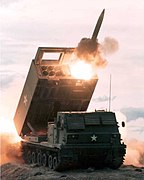Self-propelled artillery
Self-propelled artillery (also called locomotive artillery) is artillery equipped with its own propulsion system to move toward its firing position. Within the terminology are the self-propelled gun, self-propelled howitzer, self-propelled mortar, and self-propelled rocket artillery. They are high mobility vehicles, usually based on continuous tracks carrying either a large field gun, howitzer, mortar, or some form of rocket/missile launcher. They are usually used for long-range indirect bombardment support on the battlefield.
In the past, self-propelled artillery has included direct-fire vehicles, such as assault guns and tank destroyers, which were typically well-armoured vehicles often based upon the chassis of a tank. In lieu of the standard tank's general-purpose main gun that fired both high explosive and anti-tank ammunition, direct-fire vehicles had specialized roles, with assault guns providing close fire-support for infantry and tank destroyers mounting an anti-tank gun to take on enemy armour.
Modern self-propelled artillery vehicles often mount their main gun in a turret on a tracked chassis so they superficially resemble tanks. However they are generally lightly armoured which is insufficient to withstand direct-fire combat, nonetheless this protects their crews against shrapnel and small arms and are therefore usually included as armoured fighting vehicles. Many are equipped with machine guns for defense against enemy infantry.
The key advantage of self-propelled over towed artillery is that it can be brought into action much faster. Before the towed artillery can be used, it has to stop, unlimber and set up the guns. To move position, the guns must be limbered up again and brought—usually towed—to the new location. By comparison, self-propelled artillery can stop at a chosen location and begin firing almost immediately, then quickly move on to a new position. This shoot-and-scoot ability is very useful in a mobile conflict and particularly on the advance in open battlefields.[1]
Conversely, towed artillery was and remains cheaper to build and maintain. It is also lighter and can be deployed in areas that self-propelled guns cannot reach. Since the Vietnam War, heavy transport helicopters have also been used for rapid artillery deployment albeit at considerable expense and risk, mitigating one of towed artillery's disadvantages. Both self-propelled and towed artillery remain in the arsenals of many modern armies.[1]
History[edit]
Precursors[edit]
During the Thirty Years' War, early 17th century experiments were made with early types of horse artillery. Batteries towed light field guns where most or all of the crew rode horses into battle. The gunners were trained to quickly dismount, deploy the guns and provide instant fire support to cavalry, and act as a flexible reserve. The Russian army organized small units of horse artillery that were distributed among their cavalry formations in the early 18th century. While not forming large batteries and employing only lighter 2- and 3-pound guns, they were still effective and inflicted serious losses to Prussian units in the Seven Years' War. This inspired Frederick the Great to organize the first regular horse artillery unit in 1759. Other nations quickly realized the capability of the new arm and by the start of French Revolutionary Wars in 1790s Austria, Hannover, Portugal, Russia, France, Great Britain and Sweden had all formed regular units of horse artillery. The arm was employed throughout the Napoleonic Wars and remained in use throughout the entire 19th century and into the first half of the 20th century, when advances in weapons technology finally made it obsolete.[2]
Zamburak was a specialized form of self-propelled artillery from the early modern period. It featured small swivel guns to be mounted and fired from the back of camels. It was used by the Islamic gunpowder empires, especially those of Iran, especially in the rugged Iranian plateau, where the transportation of heavy cannons is difficult. [3]

